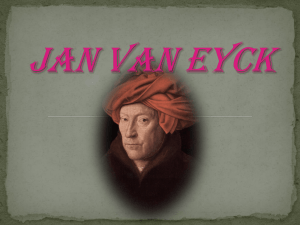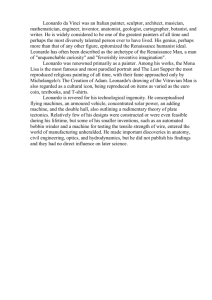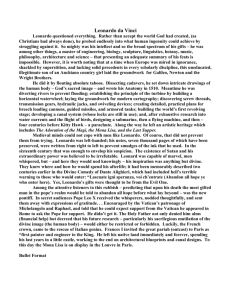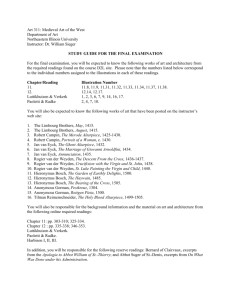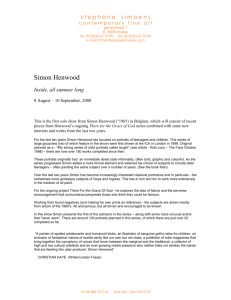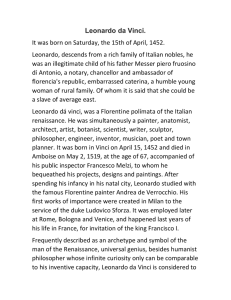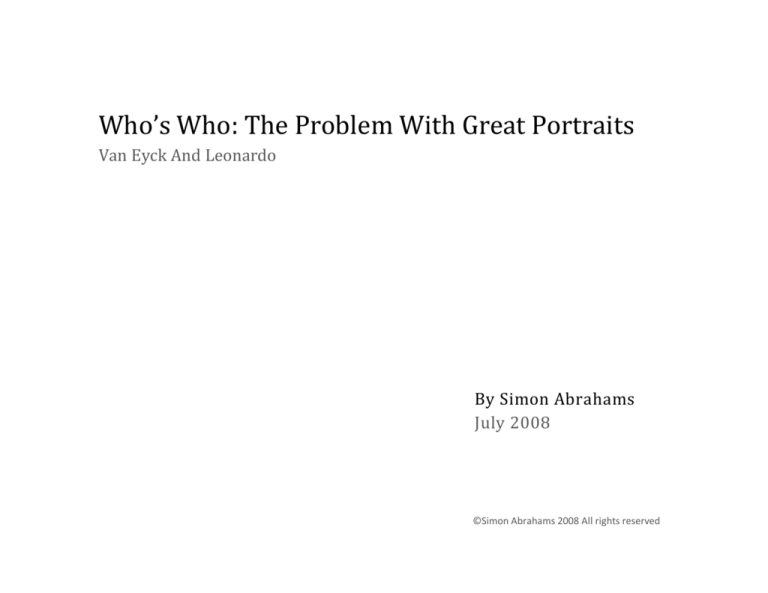
Who’s Who: The Problem With Great Portraits
Van Eyck And Leonardo
By Simon Abrahams
July 2008
©Simon Abrahams 2008 All rights reserved
Dissatisfied with conventional explanations of art? Puzzled by art’s meaning?
You are not alone. Ralph Waldo Emerson, the American poet, was so
mystified by what he had seen in the Louvre that he wrote home:
“Leonardo da Vinci has more pictures here than in any other
gallery & I like them well despite the identity of the features
which peep out of men & women. I have seen the same face in
his pictures I think six or seven times.”1
Yet no-one seems to have noted the most striking example of what Emerson
probably saw that day. The heads of St. John the Baptist and St. Anne, in
separate paintings, are identical. 2 When one is inverted and rotated, the
similarity becomes obvious (figs. 1-2). Why did Leonardo paint the same
face? And why on bodies of opposing gender? And why do art scholars not
note the exact similarities, whatever their explanation?
©Simon Abrahams 2008 All rights reserved
2
1. Leonardo, St. Anne from Virgin and Child with St. Anne
©Simon Abrahams 2008 All rights reserved
2. Leonardo, St. John from St. John the Baptist
3
Thirteen years ago a computer scientist named Lillian Schwartz made a
somewhat similar observation: that the facial proportions of the Mona Lisa
were the same as Leonardo’s (figs. 3-4).3 Demonstrating that the distance
between the various parts of the face are all identical when measured by
computer, she made no claim about Leonardo’s meaning. Her article, though,
was greeted with derision by experts and prompted headlines about Leonardo
being a transvestite. One eminent scholar announced: “Art history will
survive this crap.” 4
©Simon Abrahams 2008 All rights reserved
4
3. Leonardo, Mona Lisa (detail)
©Simon Abrahams 2008 All rights reserved
4. Leonardo, Self-portrait (detail)
5
5. Van Eyck, Man in a Red Turban (presumed self-portrait)
©Simon Abrahams 2008 All rights reserved
6. Van Eyck, Margaret Van Eyck (detail)
6
The Virgin
Arnolfini?
Angel Gabriel
All by Jan van Eyck. 7 (left): The Virgin from Chancellor Rolin and the Virgin; 8 (center): The Bride from The Arnolfini Portrait
9 (right): Angel of the Annunciation from the Ghent Altarpiece
No-one noted in the furor surrounding her article that Jan van Eyck, an
earlier pioneer of portraiture, did likewise. Although known for exacting
realism, Van Eyck painted his wife with features so like his own in a
presumed self-portrait that the resemblance is uncanny (figs. 5-6) Even if the
man is not Van Eyck, something strange is happening. So too with the
bride’s face in Van Eyck’s most famous portrait, the Arnolfini Wedding in
London (fig. 8) Her face is almost identical to those of Van Eyck’s female
Virgin and male Angel Gabriel in other paintings (figs. 7, 9). As with the Mona
Lisa, their features are in exactly the same proportion. Eyes lower, a mouth
opens but all else remains the same, even to a large extent the lighting and
pose. Can this really be the new Mrs. Arnolfini? 5
©Simon Abrahams 2008 All rights reserved
7
10. Petrus Christus, A Carthusian Monk , 1446
©Simon Abrahams 2008 All rights reserved
11. Petrus Christus, Edward Grimston, 1446
8
Nor are Van Eyck and Leonardo alone. Portraits by Petrus Christus, another
pioneer, paint a similar picture. His well-known images of a monk and an
Englishman, though each convincingly real, are too alike to be true (figs. 1011).6 One can only conclude that the two portraits, painted the same year,
are not what we think.
Portraits have long puzzled viewers for other reasons as well. Art theorists
used to wonder where the poetry was in the simple record of a person’s face
and, not finding much, dismissed portraiture as a minor art form. Their
judgment, though, had little effect on artists who continued to make portraits
and self-portraits, with Michelangelo being a rare exception. Yet the puzzle
persists, as evidenced by that common question “What’s so important about
the Mona Lisa?’
This and articles on the same subject to follow are timely because exhibitions
on portraits in 2008 are seemingly everywhere, all concerned with the
surface, the ostensible subject. The papers published here each month will
offer an alternative understanding based on the visual evidence that portraits
of others often look like the artist’s own self-portrait. The evidence will
challenge the long-held theory, first attributed to P. F. Alberti, that painted
©Simon Abrahams 2008 All rights reserved
9
art is like a view seen through a window, a replication of sight like a
photograph. If that were true, then figures by the same artist would look
different when, as Emerson noted of Leonardo and the evidence here shows,
they look similar. If, in answer to this visual problem, one imagines a great
painting not as “a window” but as “a mirror reflecting the artist’s own mind”,
one can perhaps discover the poetry in portraits that art theorists desired but
could not find. It helps explain, moreover, why artists pursued portraiture
despite such judgment.
Caveat. No apologies are made for the rotation and inversion of pictorial
details. These are simple manipulations that an artist’s mind can naturally
imagine in any age.
©Simon Abrahams 2008 All rights reserved
10
NEXT MONTH:
Gros, Napoleon at Arcole
Gros, Self-portrait
David, Napoleon in His Study
David, Self-portrait
August’s paper will focus on portraits of Napoleon. To give a glimpse of
what’s to come, two comparisons are shown above. In one, at left, the young
Napoleon is the spitting image of his artist, Baron Gros; in the other at right
by David, the faces have few similarities but Napoleon sports two locks of
hair so like the artist’s own that they must have meaning, especially since
David used the two locks on other figures elsewhere, including the dead
Marat. Portraits by great artists, we will see, are not what we think.
©Simon Abrahams 2008 All rights reserved
11
Notes
Cited in a New York Times review on Americans in Paris: A Literary Anthology, ed. Adam Gopnik (The Library of
America) 2004.
2 Kenneth Clark identified the genesis of the St. John painting in a drawing of an angel from 1505 (Popham 202)
but the face is different. Nevertheless, in those years Leonardo painted an Angel of the Annunciation very similar in
pose to the St. John. It is now known only through copies, some of which have faces similar to St. Anne’s. This
suggests that Leonardo used the same face in two different contemporaneous paintings, one now lost, and then
used the face again when painting St. John the Baptist around 1515. See Clark Leonardo da Vinci [1933], rev. ed.
(London and New York: Penguin Books) 1989, pp. 246-50
3 Lillian Schwartz,“The Art Historian’s Computer”, Scientific American 272, April 1995, pp. 106-11. Even if
Leonardo’s drawing is not a self-portrait but an “idealized type”, as Kemp claimed in 1992, the similarity of their
proportions is still of major significance, both images probably linked to a real self-portrait, now lost. (For Kemp’s
observation, see Woods-Marsden, Renaissance Self-Portraiture (New Haven and London: Yale University Press) 1998,
p. 256, note 2).
4 S. J. Freedberg, cited in Gazette des Beaux-Arts, May-June 1987, p. 11
5 Although the verisimilitude of Van Eyck’s portraits have always been praised, Lorne Campbell noted that the
heads are much enlarged. Observing distortions in the depictions of rooms as well, he concluded that “Jan did not
paint exactly what he saw but manipulated and edited reality with endless invention.” As for the Arnolfini portrait
he noted significant changes between the underdrawing of the couple’s heads, possibly sketched from life, and the
finished portraits. He thus believed that the underdrawings “may have been too obviously distorted to have been
accepted as credible images by the couple themselves” who “must have authorized the changes”. His overall
explanation for the distortions are that they “enhance likeness by stressing the most characteristic shapes of the
features and...idealize or flatter the subject without, of course, losing the likeness.” How can Van Eyck being
enhancing “likeness”, by which Campbell means their individuality, by making all his faces resemble one another?
The assumption, based on the belief that artists attempt to portray the exterior world realistically and without
meaning, does not make sense. Campbell, Renaissance Portraits: European Portrait-Painting in the 14th, 15th and
16th Centuries (New Haven: Yale University Press) 1990 pp. 105-12
6 X-rays reveal that the underdrawings are even identical. See From Van Eyck to Breughel (New York: Metropolitan
Museum of Art) 1998, p. 148
1
©Simon Abrahams 2008 All rights reserved
12

